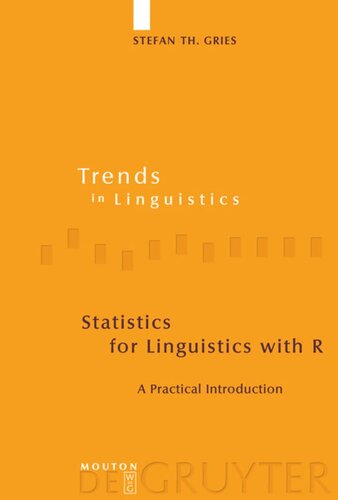

Most ebook files are in PDF format, so you can easily read them using various software such as Foxit Reader or directly on the Google Chrome browser.
Some ebook files are released by publishers in other formats such as .awz, .mobi, .epub, .fb2, etc. You may need to install specific software to read these formats on mobile/PC, such as Calibre.
Please read the tutorial at this link: https://ebookbell.com/faq
We offer FREE conversion to the popular formats you request; however, this may take some time. Therefore, right after payment, please email us, and we will try to provide the service as quickly as possible.
For some exceptional file formats or broken links (if any), please refrain from opening any disputes. Instead, email us first, and we will try to assist within a maximum of 6 hours.
EbookBell Team

4.1
50 reviewsThis book is an introduction to statistics for linguists using the open source software R. It is aimed at students and instructors/professors with little or no statistical background and is written in a non-technical and reader-friendly/accessible style.
It first introduces in detail the overall logic underlying quantitative studies: exploration, hypothesis formulation and operationalization, and the notion and meaning of significance tests. It then introduces some basics of the software R relevant to statistical data analysis. A chapter on descriptive statistics explains how summary statistics for frequencies, averages, and correlations are generated with R and how they are graphically represented best. A chapter on analytical statistics explains how statistical tests are performed in R on the basis of many different linguistic case studies: For nearly every single example, it is explained what the structure of the test looks like, how hypotheses are formulated, explored, and tested for statistical significance, how the results are graphically represented, and how one would summarize them in a paper/article. A chapter on selected multifactorial methods introduces how more complex research designs can be studied: methods for the study of multifactorial frequency data, correlations, tests for means, and binary response data are discussed and exemplified step-by-step. Also, the exploratory approach of hierarchical cluster analysis is illustrated in detail.
The book comes with many exercises, boxes with short think breaks and warnings, recommendations for further study, and answer keys as well as a statistics for linguists newsgroup on the companion website.
The volume is aimed at beginners on every level of linguistic education: undergraduate students, graduate students, and instructors/professors and can be used in any research methods and statistics class for linguists. It presupposes no quantitative/statistical knowledge whatsoever and, unlike most competing books, begins at step 1 for every method and explains everything explicitly.